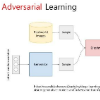A human's attention can intuitively adapt to corrupted areas of an image by recalling a similar uncorrupted image they have previously seen. This observation motivates us to improve the attention of adversarial images by considering their clean counterparts. To accomplish this, we introduce Associative Adversarial Learning (AAL) into adversarial learning to guide a selective attack. We formulate the intrinsic relationship between attention and attack (perturbation) as a coupling optimization problem to improve their interaction. This leads to an attention backtracking algorithm that can effectively enhance the attention's adversarial robustness. Our method is generic and can be used to address a variety of tasks by simply choosing different kernels for the associative attention that select other regions for a specific attack. Experimental results show that the selective attack improves the model's performance. We show that our method improves the recognition accuracy of adversarial training on ImageNet by 8.32% compared with the baseline. It also increases object detection mAP on PascalVOC by 2.02% and recognition accuracy of few-shot learning on miniImageNet by 1.63%.
翻译:人类的注意力可以通过回顾他们以前所看到的类似不折不扣的图像,直觉地适应一个图像的腐败区域。 这一观察促使我们通过考虑其清洁的图像来提高对抗性图像的注意。 为了实现这一点,我们将联合反versarial Learning(AAL)引入对抗性学习(AAL)以引导选择性攻击。我们把注意力和攻击(干扰)之间的内在关系作为改善互动的组合优化问题来表述。这导致关注回溯算法,从而能够有效地提高注意力的对抗性强力。我们的方法是通用的,可以用来处理各种任务,简单地选择不同的内核作为联合关注的焦点,为特定攻击选择其他区域的联合关注。实验结果显示,选择性攻击改善了模型的性能。我们表明,我们的方法提高了图像网对对抗性训练的准确度,比基线提高了8.32%。它还提高了对PscalVOC的物体探测 mAP的精确度,增加了2.02%,并承认微镜头网学略的精确度为1.63%。





